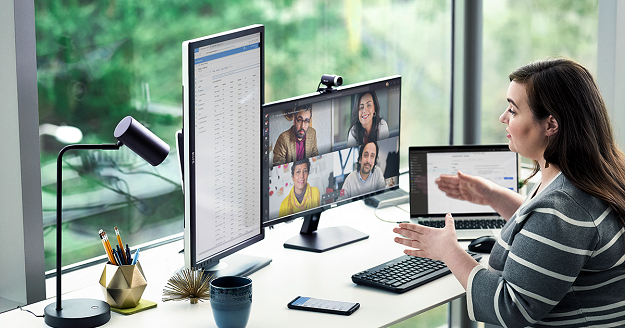Reimagining the Way we Work
By Cali Williams Yost | 5th October 2020
Top takeaways from Cali Williams Yost’s session at the 2020 National Management Conference.
1. The challenges facing leaders today
When it comes to the future of work, right now is an exceptional period in terms of the challenge’s leaders are facing. Beyond the overriding need for greater operational resilience and sustainability, leaders are being asked to support their employees’ physical and mental wellbeing, rapidly deploy and embed new technologies, build new skills around managing remote workers, and retain their top talent.
“So, these are very real, and obviously need to be addressed right now’ said Cali. ‘But what if these challenges and trends are not new? The environment is historically unprecedented, but the challenges and trends were happening before the pandemic; COVID has just accelerated them.”
2. Change is coming, but no-one is preparing for it
Leaders know that changes to work are coming, know many of the challenges they’re facing (and the answers to them), but very few are putting actual preparations into place.
Research done by HBS with 6,500 C-suite leaders in 8 countries found that, while the leaders ranked 17 ‘future of work forces’ as of significant importance, there was a large gap between the recognition of their importance and the preparations they were carrying out.
‘Why the lack of preparations?’ asked Cali. ‘Two main things. Firstly, inertia – there was no compelling forces – and secondly, leaders were unsure how to proceed. COVID has blown through both of those factors.”
3. The rebranding of flexible work

“Pre-COVID, flexible work had a real branding problem’ said Cali. ‘At the end of the day, it was seen as something that was narrowly targeted, mainly for moms and millennials.”
However, Cali’s research found there was no significant difference in terms of age, gender, seniority etc. in how much an individual wanted to work more flexibly. So, while a broad range of workers were asking for more flexible work, the policies allowing them to weren’t appropriate.
‘Because of this misunderstanding, the way flexible work was implemented was either very random and organic (based on individuals) or very structured and rigid, which led to poor adoption’ said Cali, concluding that the experimentations we’ve seen in 2020 have completely altered this mindset.
4. It’s not just remote work
Understandably, the world is focussed on remote work now in terms of flexible working; indeed, they have almost become interchangeable terms. This is a mistake.
Flexible working includes place, space, tech, time, process and pace. Remote working only falls under the ‘place’ category and without considering the other elements, any strategy will be unsustainable.
‘There is currently a myopic approach to the COVID-19 crisis in that organisations are focusing on two things – remote work and training managers. This is good, and understandable, but that alone will not get you where you need to go.”
5. Implementing a flexible work infrastructure, strategically
The flexible work infrastructure can be broken into to broad categories of place, space, tech, time, process and pace. Ideally, when implementing flexible work practices, you would first discover the state of play in your organisation within each of these categories, uncovering pockets of success, training your people, running pilot programmes, aligning these new work practices to the overall ecosystem, and then assessing the results before going again.
‘So, what happened with COVID?’ asked Cali ‘Well, everybody was thrown into pilot mode! There was no training, no alignment of the ecosystem – just throw into the deep-end and a trial by fire. We were in survival mode; the good news is that I’m beginning to see organisation’s starting to make that pivot towards stabilising how work is done.”
6. A culture of ‘Shared Leadership’
Even with the ideal infrastructure in place, without a ‘culture of shared leadership’ organisation’s will not be able to leverage the potential of flexible work practices. A cultured of shared leadership will allocate responsibility more broadly, allowing greater input and feedback from a larger array of people within an organisation, generally moving towards more collective decision-making.
‘I get asked a lot about how you help managers to sustain their resilience and the truth of the matter is to tell them they’re not alone’ said Cali. ‘They can partner with their people, and then can come together and innovate and figure out how best to work together in a partnership. And, when you do that, it opens up a whole new level of innovation, wellbeing and productivity.’
7. What must happen next
For leaders to move from the current situation to rebuilding and growing takes a holistic approach to working. Through the marrying of technology, workspace and flexibility – all within a culture of shared leadership where managers and workers can meet in the middle to make decisions – you can ‘begin to transform those challenges to opportunities for greater operating flexibility, higher levels of performance and increased talent flexibility.’
‘It begins by approaching the work from a perspective of high-performance flexibility. It’s powered by the question ‘what do we need to do… and how, when and where do we do it best?’ You’re leading with the ‘what’; you’re leading with the work.’
8. Strategic High-Performance Flexibility
Ultimately, high-performance flexibility is about an ecosystem in action. Leaders focusing on one element of that ecosystem – remote working for example – will be unable to leverage all they need to build a high-performing organisation.
For more IMI Corporate Member Insights, go here.







